TYBT2 Module Datasheet
Last Updated on : 2024-06-14 07:47:44download
Product overview
TYBT2 is a Bluetooth (Bluetooth LE) module designed by Tuya. The Bluetooth LE module consists of a highly integrated wireless Bluetooth chip TLSR8266 and some extra electric circuits that have been programmed with Bluetooth network protocol and plenty of software examples. TYBT2 further includes a low-power 32-bit MCU, the Bluetooth LE/2.4G Radio, a 512-KB flash memory, a 16-KB SRAM, and 9 I/O interfaces that can be reused.
Features
-
Integrated with the low-power-consumption 32-bit CPU, also known as the application processor
-
Clock rate: 48 MHz
-
Supply voltage range: 1.9V to 3.6V
-
Peripherals: 5×PWM, 1×I2C, 1×UART
-
Bluetooth LE RF features:
- Compatible with Bluetooth LE 4.0
- Transmitting data rate can go up to 2Mbps
- TX transmitting power: +7dBm
- RX receiving sensitivity: -92dBm
- AES hardware encryption
- Onboard PCB antenna
- Operating temperature range: -20℃ to 85℃
Main application fields
-
Intelligent LED
-
Intelligent household applications
-
Intelligent low-power consumption sensors
Dimensions and footprint
Dimensions
TYBT2 has double sides of pins. The distance between each Pin is 1.5mm.
Size of TYBT2: 15+/-0.35 mm (W)×16.5+/-0.35 mm (L)×1.63+/-0.15 mm (H).
Figure 2 shows the dimensions of TYBT2.
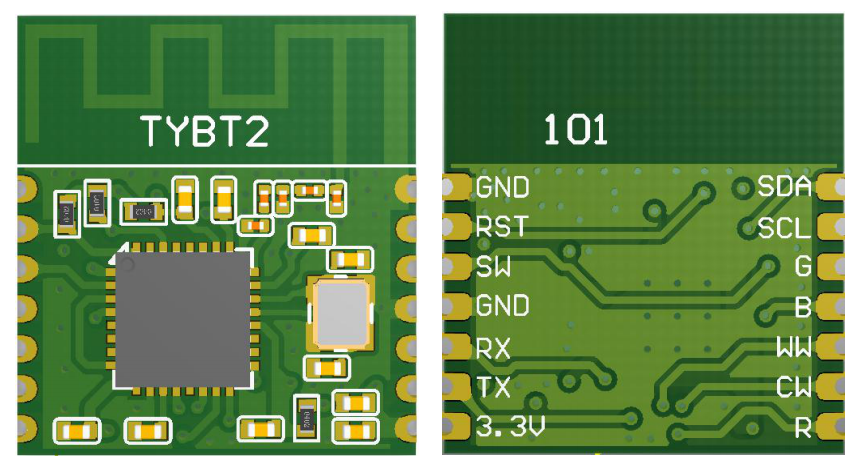
Pin Definition
Table 1 shows the general pin attributes of TYBT2
Table 1 The typical pin definition of TYBT2
| Pin NO. | Name | Type | Description |
|---|---|---|---|
| 1 | SDA | I/O | I2C, data interface, internal pull-up 4.7k resistance |
| 2 | SCL | I/O | I2C, clock interface, internal pull-up 4.7k resistance |
| 3 | G | I/O | Normal IO pin, which can be used as PWM output pin, the default for Green LED line |
| 4 | B | I/O | Normal IO pin, which can be used as PWM output pin, the default for Blue LED line |
| 5 | WW | I/O | Normal IO pin, which can be used as PWM output pin, the default for Warm White LED line |
| 6 | CW | I/O | Normal IO pin, which can be used as PWM output pin, the default for Cold White LED line |
| 7 | R | I/O | Normal IO pin, which can be used as PWM output pin, the default for Red LED line |
| 8 | 3.3V | P | Supply voltage |
| 9 | TX | I/O | UART TX, which can be used as a normal IO pin |
| 10 | RX | I/O | UART RX, which can be used as a normal IO pin |
| 11 | GND | P | Ground |
| 12 | SW | I/O | Bluetooth chipset burning pin |
| 13 | RST | I | Reset pin for the module, internal pull-up 4.7k resistance |
| 14 | GND | P | Ground |
P: Power supply pins. I/O: Digital input or output pins.- SW pin is ONLY used for burning firmware, Can NOT be used for other functions.
- While Pin4 and Pin12 are used for I2C functions, external 4.7k pull-up resistances are necessary.
- When the WW pin is outputting the PWM signal, It has an opposite phase comparing the PWM signal from the R/G/B/CW pin.
- If you have any specific needs on PWM output, please contact our BD manager.
Electrical characteristics
Absolute maximum ratings
Table 2 Absolute Maximum Ratings
| Parameter | Description | Min | Max | Unit |
|---|---|---|---|---|
| Ts | Storage temperature | -20 | 85 | ℃ |
| VCC | Supply voltage | -0.3 | 3.9 | V |
| Electrostatic discharge voltage (Human body model) | TAMB-25℃ | - | 2 | KV |
| Electrostatic discharge voltage (Machine model) | TAMB-25℃ | - | 0.5 | KV |
Electrical conditions
Table 3 Electrical Conditions
| Parameter | Description | Min | Typical | Max | Unit |
|---|---|---|---|---|---|
| Ta | Temperature for commercial grade | -20 | - | 85 | ℃ |
| VCC | Supply voltage | 2.5 | 3.3 | 3.6 | V |
| VIL | I/O low-level input | -0.3 | - | VCC*0.25 | V |
| VIH | I/O high-level input | VCC*0.75 | - | VCC | V |
| VOL | I/O low-level output | - | - | VCC*0.1 | V |
| VOH | I/O high-level output | VCC*0.8 | - | VCC | V |
Transmitting current consumptions
Table 4 TX current consumption
| Parameter | Mode | Typical | Unit |
|---|---|---|---|
| Itx | Continuously transmitting, 0dBm power output | 13 | mA |
| Irx | Continuously receiving | 13 | mA |
| IDC | Normal working mode | 80 | μA |
Radio specification
Basic Radio frequency characteristics
Table 5 Basic Radiofrequency characteristics
| Parameter | Description |
|---|---|
| Working Frequency | 2.4GHz ISM band |
| Radio standard | Bluetooth LE 4.0 |
| Data transmitting rate | 1Mbps |
| Type of Antenna | On-board PCB Antenna |
Transmitting power
Table 6 Transmitting power
| Parameter | Min | Typical | Max | Unit |
|---|---|---|---|---|
| RF Average output power consumption | 3.8 | 7 | - | dBm |
| 20dB bandwidth | - | 1000 | - | KHz |
Receiving sensitivity
Table 7. Receiving sensitivity
| Parameter | Min | Typical | Max | Unit | |
|---|---|---|---|---|---|
| RX sensitivity | 1Mbps | -93 | -92 | -90 | dBm |
| Frequency bias error | - | -300 | - | 300 | KHz |
| Co-channel interference Restrain | - | - | -7 | - | dB |
Antenna
Antenna type
TYBT2 uses a 2.4-GHz MIFA onboard PCB antenna.
Reduce antenna interference
In order to have the best RF performance, it’s recommended to keep a minimum 15mm distance between the antenna and the other metal pieces.
Since the PCBA manufacturer uses the SMT process to weld the TYBT2 module and other electrical components onto the PCB board, RF performance will depend on the layout location and pattern of the onboard PCB antenna. The following figures are some recommended and dis-recommended demonstrations from our R&D team.
In demonstrations 1 and 2 of figure 3, the onboard PCB antenna lies outside of the PCB frame. It’s recommended to use the layout pattern shown in demonstrations 1 and 2. Either the onboard PCB antenna lies outside of the PCB frame directly or the PCB frame carves out a certain area for the antenna. The overall PCBA performance for these two ways will be the same as testing the module independently.
Restricted due to some reason, if the onboard PCB antenna layout has to be inside the PCB frame, it’s suggested to refer to demonstration 3. The antenna lies inside the PCB frame, but no copper or wire beneath the antenna. RF performance will have some loss, Approximately 1~2 dBm.
It’s NOT recommended to use demonstration 4, the antenna lies inside the PCB frame, and there are copper and wire beneath it. RF performance will have significant attenuation.
Figure 3. layout demonstrations
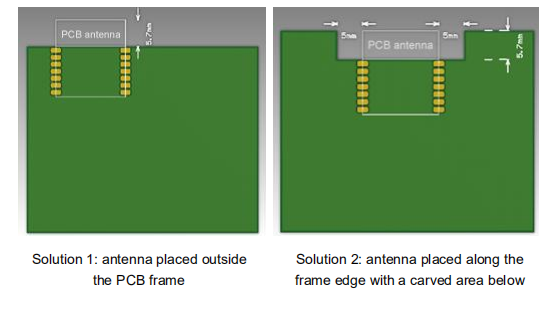
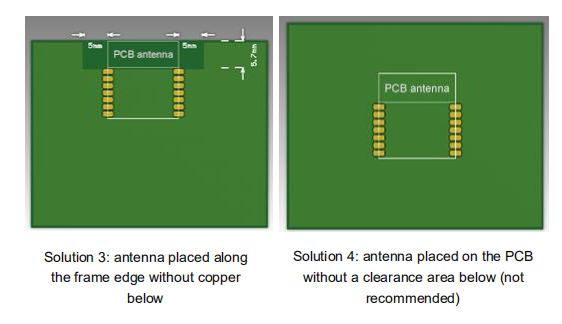
Packaging information and production guide
Mechanical dimensions
Figure 4 Dimensions of the module
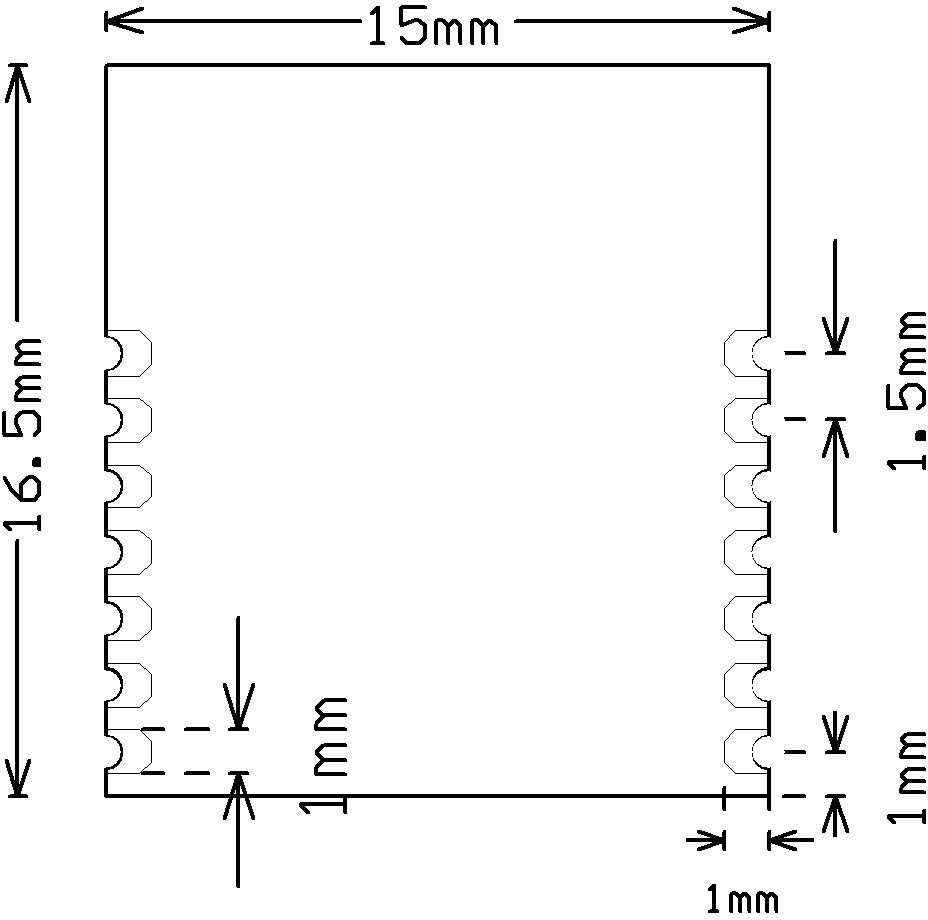
Production instructions
-
The Tuya SMT module should be mounted by the SMT device. After being unpacked, it should be soldered within 24 hours. Otherwise, it should be put into the drying cupboard where the RH is not greater than 10%; or it needs to be packaged under vacuum again and the exposure time needs to be recorded (the total exposure time cannot exceed 168 hours).
- SMT devices:
- Mounter
- SPI
- Reflow soldering machine
- Thermal profiler
- Automated optical inspection (AOI) equipment
- Baking devices:
- Cabinet oven
- Anti-electrostatic and heat-resistant trays
- Anti-electrostatic and heat-resistant gloves
- SMT devices:
-
Storage conditions for a delivered module:
-
The moisture-proof bag must be placed in an environment where the temperature is below 40°C and the relative humidity is lower than 90%.
-
The shelf life of a dry-packaged product is 12 months from the date when the product is packaged and sealed.
-
There is a humidity indicator card (HIC) in the packaging bag.
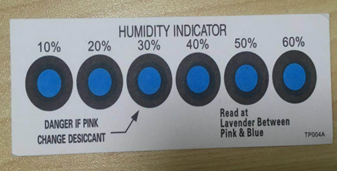
-
-
The module needs to be baked in the following cases:
- The packaging bag is damaged before unpacking.
- There is no HIC in the packaging bag.
- After unpacking, circles of 10% and above on the HIC become pink.
- The total exposure time has lasted for over 168 hours since unpacking.
- More than 12 months have passed since the sealing of the bag.
-
Baking settings:
- Temperature: 40°C and ≤ 5% RH for reel package and 125°C and ≤5% RH for tray package (please use the heat-resistant tray rather than a plastic container).
- Time: 168 hours for reel package and 12 hours for tray package.
- Alarm temperature: 50°C for reel package and 135°C for tray package.
- Production-ready temperature after natural cooling: < 36°C.
- Re-baking situation: If a module remains unused for over 168 hours after being baked, it needs to be baked again.
- If a batch of modules is not baked within 168 hours, do not use the reflow soldering to solder them. Because these modules are Level-3 moisture-sensitive devices, they are very likely to get damp when exposed beyond the allowable time. In this case, if they are soldered at high temperatures, it may result in device failure or poor soldering.
-
In the whole production process, take electrostatic discharge (ESD) protective measures.
-
To guarantee the passing rate, it is recommended that you use the SPI and AOI to monitor the quality of solder paste printing and mounting.
Recommended oven temperature curve
Set oven temperatures according to the following temperature curve of reflow soldering. The peak temperature is 245°C.
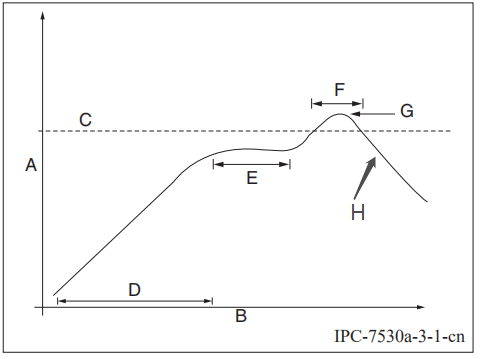
-
A: Temperature axis
-
B: Time axis
-
C: Liquidus temperature: 217 to 220°C
-
D: Ramp-up slope: 1 to 3°C/s
-
E: Duration of constant temperature: 60 to 120s; the range of constant temperature: 150 to 200°C
-
F: Duration above the liquidus: 50 to 70s
-
G: Peak temperature: 235 to 245°C
-
H: Ramp-down slope: 1 to 4°C/s
Note: The above curve is just an example of the solder paste SAC305. For more details about other solder pastes, please refer to Recommended oven temperature curve in the solder paste specifications.
Storage conditions
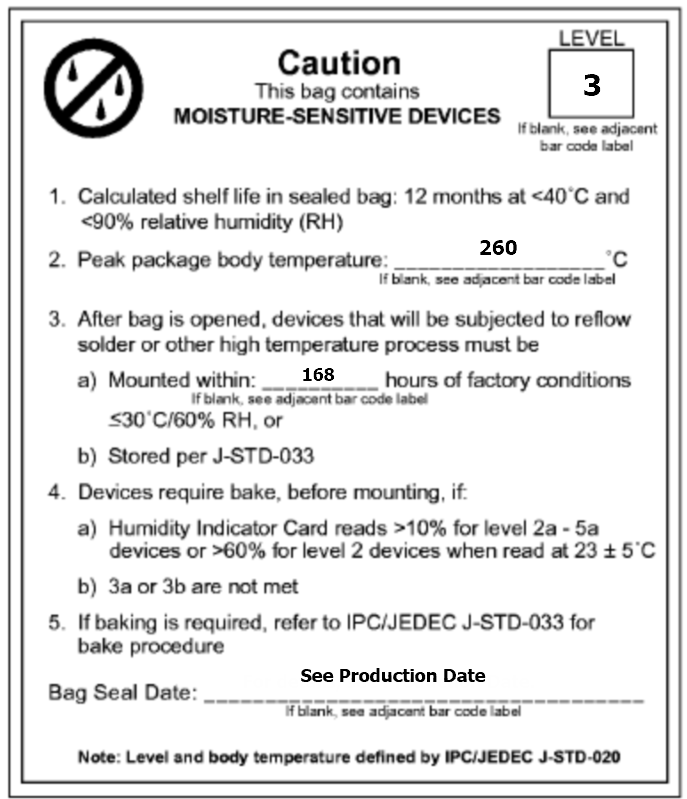
MOQ and packaging information
| Product number | MOQ (pcs) | Shipment packaging method | The number of modules per reel | The number of reels per carton |
|---|---|---|---|---|
| TYBT2 | 4000 | Tape reel | 1000 | 4 |
Appendix-Statement
FCC Caution: Any changes or modifications not expressly approved by the party responsible for compliance could void the user’s authority to operate this device.
This device complies with Part 15 of the FCC Rules. Operation is subject to the following two conditions: (1) This device may not cause harmful interference, and (2) this device must accept any interference received, including interference that may cause undesired operation.
Note: This device has been tested and found to comply with the limits for a Class B digital device, according to part 15 of the FCC Rules. These limits are designed to provide reasonable protection against harmful interference in a residential installation. This device generates, uses, and can radiate radio frequency energy and, if not installed and used following the instructions, may cause harmful interference to radio communications. However, there is no guarantee that interference will not occur in a particular installation.
If this device does cause harmful interference to radio or television reception, which can be determined by turning the device off and on, the user is encouraged to try to correct the interference by one or more of the following measures:
- Reorient or relocate the receiving antenna.
- Increase the separation between the device and receiver.
- Connect the device into an outlet on a circuit different from that to which the receiver is connected.
- Consult the dealer or an experienced radio/TV technician for help.
Radiation Exposure Statement
This device complies with FCC radiation exposure limits set forth for an uncontrolled rolled environment. This device should be installed and operated with a minimum distance of 20cm between the radiator and your body.
Important Note
This radio module must not be installed to co-locate and operating simultaneously with other radios in the host system except following FCC multi-transmitter product procedures. Additional testing and device authorization may be required to operate simultaneously with other radios.
The availability of some specific channels and/or operational frequency bands are country dependent and are firmware programmed at the factory to match the intended destination. The firmware setting is not accessible by the end-user.
The host product manufacturer is responsible for compliance with any other FCC rule that applies to the host not covered by the modular transmitter grant of certification. The final host product still requires Part 15 Subpart B compliance testing with the modular transmitter installed.
The end-user manual shall include all required regulatory information/warnings as shown in this manual, including “This product must be installed and operated with a minimum distance of 20 cm between the radiator and user body.”
The RF module is considered as a limited modular transmitter according to FCC rules. Even though the RF module gets an FCC ID, the host product manufacturer can not use the FCC ID on the final product directly. In these circumstances, the host product manufacturer integrator will be responsible for re-evaluating the end product (including the transmitter) and obtaining the FCC authorization by a Class II permissive change application or a new application.
Declaration of Conformity European Notice

Hereby, Hangzhou Tuya Information Technology Co., Ltd declares that this module product is in compliance with essential requirements and other relevant provisions of Directive 2014/53/EU,2011/65/EU. A copy of the Declaration of conformity can be found at https://www.tuya.com.
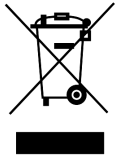
This product must not be disposed of as normal household waste, in accordance with the EU directive for waste electrical and electronic device (WEEE- 2012/19/EU). Instead, it should be disposed of by returning it to the point of sale, or to a municipal recycling collection point.
The device could be used with a separation distance of 20cm to the human body.
Is this page helpful?
YesFeedbackIs this page helpful?
YesFeedback





